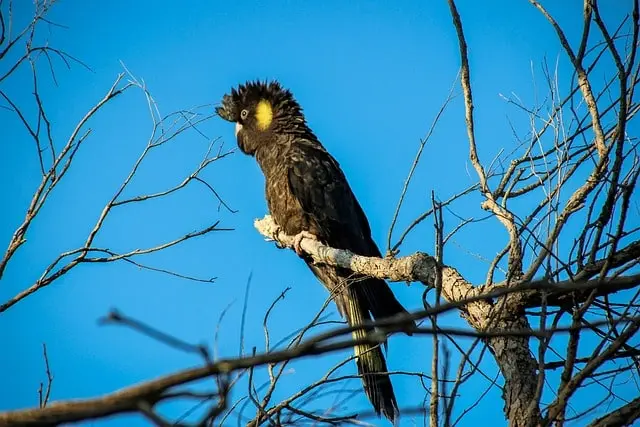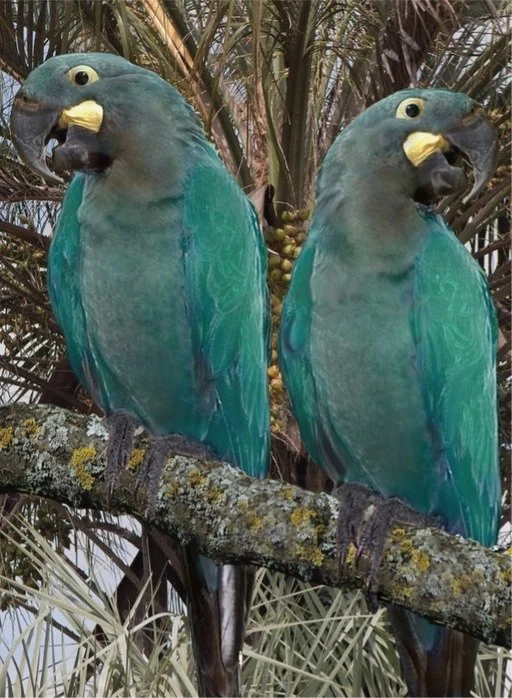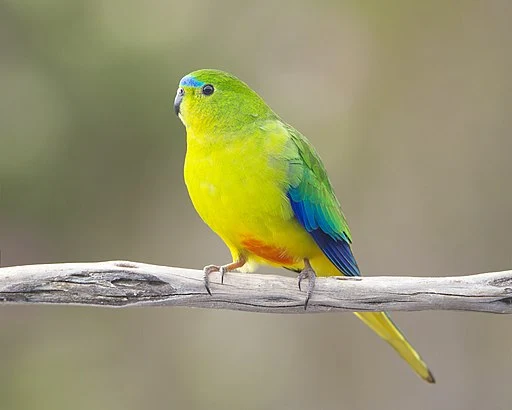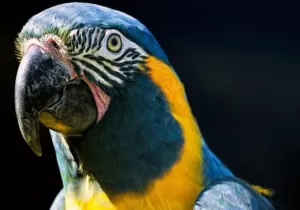Parrots are one of the most threatened bird species in the world. Their population has been declining for decades as illegal poaching became rampant in the 1970s and habitats were being destroyed due to deforestation and human activity.
Wild bird poaching has been a significant reason why some of the parrot species have become endangered and even extinct. Unlike some other species that can produce large numbers of offspring, parrots have slower reproductive cycles, which makes it challenging for parrot populations to recover from declines caused by habitat loss, illegal trade, and other threats.
Today, there are laws against parrot poaching, and many organizations have actively undertaken initiatives to safeguard endangered parrot species.
Quick Navigation
Rare Parrot Species
Here are 12 rare parrot species that you might not know about:
Glossy Black-cockatoo

The glossy black cockatoo is one of five species of black cockatoo native to Australia. It has a black plumage with red/orange tail panels.
They are sexually dimorphic, which means the males and females can be physically told apart. The females have the same black body, but they have irregular yellow markings on their faces.
The glossy black cockatoo is the shortest among the black cockatoos of Australia measuring 18–19.5 inches in length. They are mostly found in woodlands and open forests and exclusively eat seeds of she-oaks.
Glossy Black-Cockatoos are an endangered parrot species with a declining population. They face threats from habitat destruction and predation from Brushtail Possums. According to the Government Of South Australia, the current population of Glossy Black-Cockatoos is between 290-300 birds.
| Scientific Name | Calyptorhynchus lathami |
| Estimated Population | 290-300 |
| Conservation Status | Endangered |
Imperial Amazon
The Imperial Amazon is the national bird of Dominica endemic to the archipelago of Lesser Antilles. It is a rare and beautiful bird and can only be seen in its limited geographical range.
The plumage of the Imperial Amazon comprises a rare blend of colors. The Imperial Amazon is primarily purple and green colored. It has a purple forehead, chest, and abdomen with contrasting forest-green wings. Purple is the rarest color in the parrot kingdom and the imperial Amazon has the most extensive and pronounced purple plumage.
The imperial Amazon is a critically endangered species with only 50 mature individuals left in the wild as of 2019. A major reason for the population decline has been hurricanes that destroyed their habitat.
Hurricane David in 1979 wiped out a large chunk of their population and it took nearly two decades for the imperial amazons to reestablish its population. However, the recent Hurricane Maria in 2017 again caused a substantial decline in the population number of the imperial amazons.
| Scientific Name | Amazona imperialis |
| Estimated Population | 50 |
| Conservation Status | Endangered |
Puerto Rican Amazon
Puerto Rican Amazon is a rare parrot that once spread across the islands of Puerto Rico. Its plight is similar to that of the Imperial Amazon of Dominica. The Puerto Rican Amazon’s population has been hit majorly by Hurricanes, predators, poaching, and land clearance.
World Parrot Trust has played a crucial role in the recovery of the Puerto Rican Amazon by supporting breeding programs of the species in captivity. The Puerto Rican Parrot population faced a significant decline in 1975, reaching a low of only 13 birds.
By 2017, the breeding facilities had successfully increased the parrot population to more than 400 individuals, with an additional 130 parrots in the wild. However, the population faced a setback in 2017 when Hurricane Maria caused the loss of 70-80 wild parrots.
| Scientific Name | Amazona vittata |
| Estimated Population | 50 – 80 in the wild and around 400 in captivity |
| Conservation Status | Critically Endangered |
Blue-throated Macaw

The blue-throated Macaw is a rare species of macaw endemic to the Beni savannahs of Bolivia. The blue-throated macaw was thought to be extinct until 1992 when they were sighted in South America.
Currently, it is listed as a critically endangered species by the IUCN Red List and has population numbers of mature individuals between 208 and 303.
Blue-throated macaws have gone through a lot through the decades with illegal trapping for the wild bird trade and habitat reduction. Cattle grazing and savanna burning have also negatively influenced the ecological requirements of these birds.
Long-term conservation efforts have been implemented to stabilize the population of the species. These include increasing the involvement of landowners to enhance protection for wild macaws, collaborating with the Bolivian government to develop strategies against macaw trapping for bird trade, and exploring the potential application of private reserves within the Blue-throated Macaw range.
| Scientific Name | Ara glaucogularis |
| Estimated Population | 208 – 303 |
| Conservation Status | Critically Endangered |
Spix’s Macaw
The spix’s Macaw was declared extinct in the wild in the year 2000 and has since then only existed in captivity. There are currently around 177 Spix’s macaws in captivity.
A journal published by Science Magazine describes the efforts made to save the last of the Spix’s macaw in the wild.
In 1995, the spix’s macaw was recognized as the rarest parrot in the wild with only one male remaining that was identified through DNA testing.
With fewer than three dozen individuals known to exist in zoos worldwide, a decision was made to release a single female near the male’s location, hoping that they would form a pair and reproduce.
However, after a little over two months, the female mysteriously disappeared and soon the male was also never seen again.
Before going extinct from its habitat range, the Spix’s macaw was heavily poached for pet bird trade and also suffered from deforestation and climate change.
Because of movies like Rio, and other documentaries, the Spix’s macaw gained recognition and the evils of poaching have been brought to light to the public.
| Scientific Name | Cyanopsitta spixii |
| Estimated Population | 177 |
| Conservation Status | Extinct in the wild |
Glaucous Macaw

The glaucous macaw is the smallest of the blue macaws measuring just under 30 inches. In the past century, this species was commonly found in specific regions of Paraguay and neighboring areas, including along the Paraná River. However, the Glaucous Macaw has faced a dramatic population decline.
The last sighting of the glaucous macaws was observed by a scientist in the Jardin d’Acclimation in Paris, sometime between 1895 and 1905. Since then, there have been no confirmed sightings of the Glaucous Macaw in the wild.
The IUCN red list has classified the glaucous macaw as critically endangered. Some scientists even believe that it may be extinct. There is no confirmed population number of this species but the IUCN states there might be 0-20 individuals.
| Scientific Name | Anodorhynchus glaucus |
| Estimated Population | 0-20 |
| Conservation Status | Critically Endangered |
Kākāpō

The Kākāpō is a rare and one of the most unique parrots. It is a large nocturnal parrot native to New Zealand and also the only flightless parrot. The Kākāpō once flourished in the islands of New Zealand and are known to live up to 90 years.
However, in the mid-1900s, their population saw a steep decline due to hunting, land clearance, and the introduction of predators like stoats, possums, and snakes. Its current population is estimated to be 247 as of 2023.
Thankfully, the population of Kākāpō is rising due to concentrated conservation efforts. Recent conservation efforts have focused on establishing secure populations through the translocation of wild-caught kakapo to offshore islands that are not inhabited by their predators.
A total of 65 kakapo were translocated to four offshore islands between 1974 and 1992 namely Mana, Maud, Little Barrier, and Codfish.
| Scientific Name | Strigops habroptilus |
| Estimated Population | 247 |
| Conservation Status | Critically Endangered |
Indigo-winged Parrot
The indigo-winged parrot also known as the Fuertes’s parrot is a small bird found in Colombia. It has a small geographical coverage of about 143 square miles in the central Andes. It has beautiful golden-green feathers on the body and indigo-colored underwings.
It was thought to be extinct for nearly 90 years until 2002 when it was rediscovered by biologists from Fundación ProAves, a Colombian nonprofit organization.
After its rediscovery, extensive conservation and protection measures were put in place including the establishment of a 1,619-acre Fuertes’s Parrot Reserve and a number of other reserves.
Its current population is estimated to be around 230 – 300 mature individuals with rising numbers. However, habitat loss is still one of the major factors affecting its population.
| Scientific Name | Hapalopsittaca fuertesi |
| Estimated Population | 230 – 300 |
| Conservation Status | Critically Endangered |
Sulu Racquet-tail
The blue-winged racquet-tail or the Sulu Racquet-tail is a medium-sized parrot that inhabits the lowland forests of the Sulu archipelago. The Sulu racquet tail was listed as critically endangered in 2016 and currently, its population is estimated to be 50-249 mature individuals.
Habitat loss and illegal trapping are one of the main threats causing continual decline. These birds are said to exhibit tame behavior, which makes it easier for them to be caught.
Reportedly, numerous birds were killed for target practice on the island of Tawi Tawi. There have been several proposals for the protection of the blue-winged racquet tail, however, not many conservation actions have been initiated.
| Scientific Name | Prioniturus verticalis |
| Estimated Population | 50-249 |
| Conservation Status | Critically Endangered |
New Caledonian Lorikeet
The New Caledonian Lorikeet is a species of parrot endemic to New Caledonia, a French territory in the southwestern Pacific Ocean. It is a small green parrot with slender wings and an orange bill.
However, apart from its physical characteristics, not much is known about this bird. The New Caledonian lorikeet is one of the rarest parrots in the world with only 50 estimated birds in the wild.
| Scientific Name | Vini diadema |
| Estimated Population | 50 |
| Conservation Status | Critically Endangered |
Red-throated Lorikeet
The red-throated Lorikeet has been a rare species since its discovery with a restricted range. These parrots are found on several islands in Fiji including Viti Levu, Ovalau, Vanua Levu, and Taveuni.
The last official sighting of the red-throated lorikeet was made in 1993. Through the years there have been numerous surveys on the island of Viti Levu, though none of them were successful.
The species is classified as critically endangered and the total population is said to be around 50 individuals in the wild.
| Scientific Name | Vini amabilis |
| Estimated Population | 50 |
| Conservation Status | Critically Endangered |
Orange-bellied Parrot

The Orange-bellied Parrot hails from southern Australia and is one of only three migratory parrot species. Its population has been declining for decades due to a variety of external stresses including predation from foxes, and feral cats, the spread of diseases, and the most pressing of the challenges has been the clearing of forests and cutting of trees where it breeds.
By the 1990s, its population was already as low as 170 individuals. The IUCN Red List has classified the orange-bellied parrot as Critically Endangered and estimates the number of mature birds to be somewhere in the range of 20-25.
The ongoing conservation efforts to protect and restore the habitat of the Orange-bellied Parrot in Tasmania and mainland Australia have involved minimizing predatory risk and facilitating breeding programs in Zoos to hopefully one day rebuild its population in the wild.
| Scientific Name | Neophema chrysogaster |
| Estimated Population | 20-25 |
| Conservation Status | Critically Endangered |







